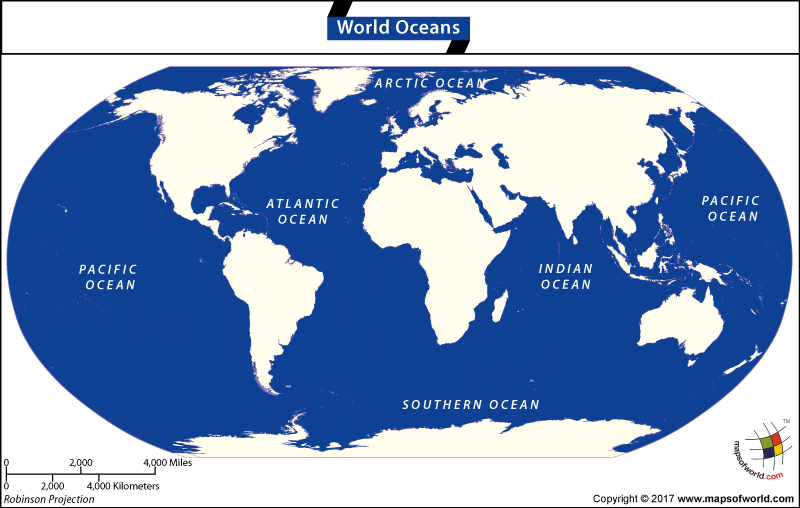

World map showing world oceans
The word “ocean” comes from the Latin word “Okeanos,” which means the “great stream encircling the earth’s disc.” The ancient Greeks used this term to describe the huge body of water they thought surrounded the earth. In this article , we will learn about how many oceans in the world, and more.
There is only one ocean on planet Earth. Different names have been given to the ocean based on geographical, navigational, scientific, and historical reasons. Historically, explorers and geographers have recognized the existence of 4 oceans- the Pacific, Atlantic, Arctic, and Indian Ocean. The Antarctic Ocean, also known as the Southern Ocean, is a more recent addition to the list.
The largest of all Oceans, the Pacific spreads over 64 million square miles. The name “Pacific” comes from the Latin word “pacificus,” which means “peaceful”. The Portuguese explorer Ferdinand Magellan named it “Mar Pacífico” (peaceful sea) in 1520 because of the calm waters he encountered when he first entered the ocean.
Interesting Facts
The second largest ocean covers about 32 million square miles. In Greek mythology, Atlas, son of the Titan Iapetus, Oceanid Asia or Clymine, was ordered by Zeus to uphold the weight of the Heavens on his shoulders, as a punishment for eternity. The name “Atlantic” derives from Greek mythology, referring to the “Sea of Atlas.” The name Atlantic is inspired by Atlas and the waters off the west coast of Africa came to be referred to as Atlantic.
Interesting Facts
Spread over 29 million square miles, the Indian Ocean gets its name from the Indian Coast which served as a reference for early maritime explorers. This is the only ocean to be named after a country.
Interesting Facts
The Arctic is the smallest of all oceans covering just 5 square miles. The ocean gets its name from the Greek word “Arktos” meaning bear. Early Greeks identified the constellation- Ursa Major or Great Bear, as the navigational guide pointing to the North Star or Polaris. From that period, mariners have used this information to navigate the seas with reference to the North Star. The image of Atlas carrying the earth on his shoulders is symbolic and displayed in the world map in the above context.
Interesting Facts
The ocean covers 20.32 million square miles in the southern hemisphere. The name Antarctic refers to the opposite of the Arctic. While the Arctic ocean lies in the northernmost part of the Earth, the Antarctic or Southern Ocean covers the southern part of the planet.
Interesting Facts
Related Links
The Republic of Madagascar is an island country located in the Indian Ocean, off the…
The Euro is the official currency of the European Union. It is, however, not incumbent…
There are many countries or regions that are partially recognized by the UN, have disputes…
The Alaska Statehood Act was signed into law by President Dwight D. Eisenhower in 1958,…
The name Persia may, however, only be used to refer to Iran in some contexts.…
Hawaii is an Island State in the US. It is one of the 50 states…